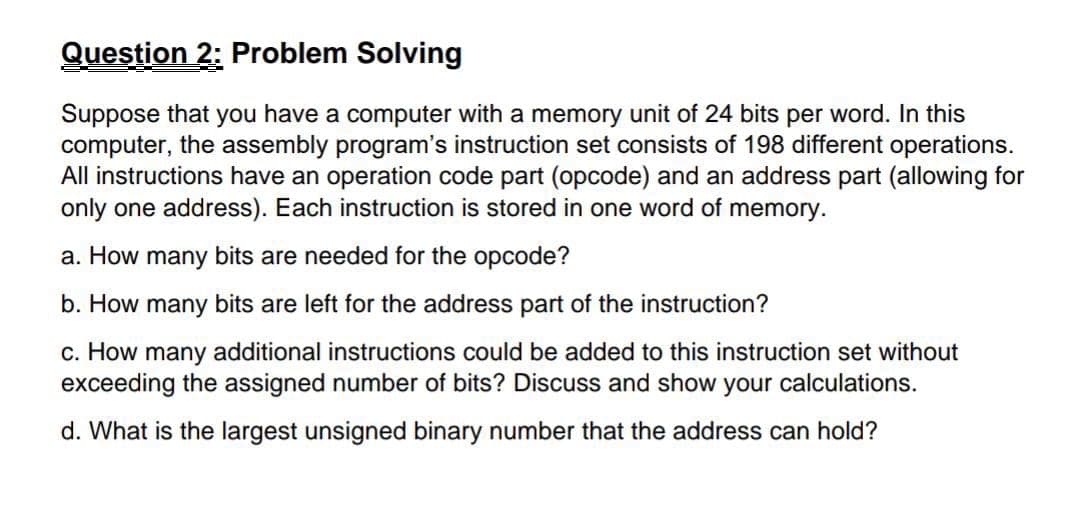Question 2: Problem Solving Suppose that you have a computer with a memory unit of 24 bits per word. In this computer, the assembly program's instruction set consists of 198 different operations. All instructions have an operation code part (opcode) and an address part (allowing for only one address). Each instruction is stored in one word of memory. a. How many bits are needed for the opcode? b. How many bits are left for the address part of the instruction? c. How many additional instructions could be added to this instruction set without exceeding the assigned number of bits? Discuss and show your calculations. d. What is the largest unsigned binary number that the address can hold?
Question 2: Problem Solving Suppose that you have a computer with a memory unit of 24 bits per word. In this computer, the assembly program's instruction set consists of 198 different operations. All instructions have an operation code part (opcode) and an address part (allowing for only one address). Each instruction is stored in one word of memory. a. How many bits are needed for the opcode? b. How many bits are left for the address part of the instruction? c. How many additional instructions could be added to this instruction set without exceeding the assigned number of bits? Discuss and show your calculations. d. What is the largest unsigned binary number that the address can hold?
Chapter4: Processor Technology And Architecture
Section: Chapter Questions
Problem 2PE: If a microprocessor has a cycle time of 0.5 nanoseconds, what’s the processor clock rate? If the...
Related questions
Topic Video
Question
Solve all

Transcribed Image Text:Question 2: Problem Solving
Suppose that you have a computer with a memory unit of 24 bits per word. In this
computer, the assembly program's instruction set consists of 198 different operations.
All instructions have an operation code part (opcode) and an address part (allowing for
only one address). Each instruction is stored in one word of memory.
a. How many bits are needed for the opcode?
b. How many bits are left for the address part of the instruction?
c. How many additional instructions could be added to this instruction set without
exceeding the assigned number of bits? Discuss and show your calculations.
d. What is the largest unsigned binary number that the address can hold?
Expert Solution
This question has been solved!
Explore an expertly crafted, step-by-step solution for a thorough understanding of key concepts.
Step by step
Solved in 2 steps with 1 images

Knowledge Booster
Learn more about
Need a deep-dive on the concept behind this application? Look no further. Learn more about this topic, computer-science and related others by exploring similar questions and additional content below.Recommended textbooks for you

Systems Architecture
Computer Science
ISBN:
9781305080195
Author:
Stephen D. Burd
Publisher:
Cengage Learning

Systems Architecture
Computer Science
ISBN:
9781305080195
Author:
Stephen D. Burd
Publisher:
Cengage Learning